|
Phantom
Brave (PS2)
From NIS
This is a
game that I had long awaited when I first learned it was
coming to the states. That would be about a year ago, as I was
playing La Pucelle Tactics (shortly after finishing Disgaea).
Yeah. I got hooked on NIS games. They were able to take the
old tactical RPG genre and give it new life through unique
twists on both plot (and narrative style) and game play
elements.
Phantom
Brave seemed to offer the same levels of uniqueness that would
once again show to the world that NIS could breath new life
into an aging genre. However, before I could play it and find
out for myself if this would be true, I had to wait. Phantom
Brave had the misfortune of coming in the Fall of 2004. This
was that horrible time when too many good games came out, and
there was too little time and money for a geek to enjoy them
all. So, I pushed back PB until I figured I could fit it into
my schedule. That would be the Spring of 2005.
So, in the
end, the big question still remains. Did NIS continue their
magic and help to further redefine this genre? Let's
see...
Plot
Let's try to
be nice here...ok, screw that...the plot is horrible. I hate
to say it, but NIS forgot to include a real plot in this game.
In fact, after 30+ hours to finish the real quest, I am still
left wondering if half of the game was even needed.
The primary
plot is really simple. About 8 years ago, three chromas
(mercenaries) went to the Island of Evil. Yeah. NIS was so
uncreative this time that they even resorted to naming the
most evil island in the island nation of Ivoire "Island
of Evil". Yeah, that's original. Anyway, these three
chromas get killed by an (yeah, you guessed it) evil monster.
As a final show of power, one of them does some sort of magic
on Ash, a member of these three chromas.
8 years
later, we are introduced to Marona. She's the child of two of
these dead chromas. We also see the one who was effected by
the final magic spell is still with her, as a phantom. Marona
is determined to become a great chroma, like her parents, with
the help of Ash and her ability to summon phantoms to do her
bidding. However, she also has to deal with the resentment of
the common people due to her ability to summon phantoms. For
this, she is dubbed "the possessed one" and is
shunned by all. Her only solace is to live on "Phantom
Island" by herself, with a chance to occasionally do a
job to earn her living and to help out those who need
help.
It sounds
like the start of a great story, right? Ok, the start of a
good story, at least. Well, that's were this plot line ends
for a long time. I think it would be considered a spoiler to
reveal anymore, since we don't learn anymore for about 10
hours of game play. Needless to say, it will eventually
involve a great evil coming back from a 30 year banishment to
the Island of Evil (surprised? I didn't think you would
be).
As Marona
helps out people, she also slowly finds friends and removes
the stigma against her. This part of the plot is very similar
to Legend of Mana (Square, for the PSX). You see small
glimpses of side characters from time to time and soon learn
how they all inter-relate to the state of the world. However,
unlike LoM, this is don't in a bit too brief and blunt of a
way to ever feel yourself being attached to the plot.
Overall, the
plot is just not present. More times than not, an episode (the
game is split into 20 episodes) will feel as worthwhile as an
episode of a common sitcom. In other words, you will find
yourself wondering if that really was the best way to use 1-2
hours of game play. You will also usually come to the same
conclusion; nope, it was a waste of time.
Game Play
PB takes a
different take on the standard tactical RPG rules that the
classics, like Shining Force, have used. It goes with NIS's
philosophy of always trying to do things a little differently.
With Disgaea, they showed some interesting uses of abilities
to throw enemies to create more powerful foes, with La Pucelle
Tactics they had energy streams and exorcisms to control or
destroy powerful foes. Well, with PB they kept up the idea of
keeping things fresh and different. However, this time they
may have taken things a little too far.
First off,
the grid system of SF, Disgaea, and LPT is gone. You can move
freely in any direction. You also can attack in the same grid
free method. It's basically like what was done with Arc the
Lad: TotS. It's nothing new, but it is something that has been
done successfully and should have been continues from Arc's
lead. This is a very good way to manage many combatants in a
limited area (the battle map). It means that you can have more
strategy in your combat, and it means that a minor mistake
could be far more costly as you accidentally move too many
characters a little too close as an enemy spellcaster moves in
with a massive AoE spell ready to fire. There is nothing wrong
with giving this extra level of control, and strategy.
However,
there is something quite wrong with PB's method of dispatching
fighters to a battle. You have to "confine" each of
Marona's phantoms into objects to have them participate in
combat. Also, each phantom only has a limited number of turns
before they are un-confined from battle. On top of this,
whatever you summon a phantom into will effect it's abilities.
If you place a phantom in a rock, it will obviously be more
defensive, but it will also be slower. If you place an object
in a plant, it will be more intelligent (since flowers are...ummm...smart?).
While this gives you more strategy in a battle, it can also
cause more frustration as the game will often times be rather
stingy, in later levels, on how many objects are present and
what type of bonuses and penalties they give. You'll find
mages are not welcome in the last few chapters as the plants
vanish from the battle field.
Also, each
object may have an effect on it from another object that will
further complicate things. For example, THAT stump in the
corner may be forcing all of the objects it influences to be
invincible. So, if you confine a phantom in one of the influenced
objects, it will be invincible. However, the enemies may be
under that influence too. This means you'll be forced to
determine, in very few turns (since your phantoms will only be
confined for 4 or 5 turns, at best, on average) to eliminate a
certain object to initiate combat. Also, if you confine a
phantom to this object that's granting the invincibility, then
you will have to either wait for your character to no longer
be confined, or you'll have to kill this phantom, to destroy
the object to start to initiate actual combat.
If you're
starting to think this is a good thing, you are thinking
right, but you're ignoring the fact that NIS made some poorly
designed battle fields, and this type of over-strategizing is
only going to give the player a headache. It is not fun to
have to plan combat about 10 rounds into the future with each
battle. Plus, once all of your good combatants have been
confined and have poofed, you will be left with the wussiest
RPG character of all time (Marona) to die on her own from
weaker enemies.
As for
equipment, your characters can each be confined with a pre-set
item in their possession. This item can bhe anything from a
scroll (for spells), to a weapon, to a rock, to a fish, to a
flower, to whatever else you can find. You can either buy
these items (which is hard at the start since you don't start
to really make money in PB until the 10th or so episode), or
you may, depending on your characters stats, steal it with
your character when it's time to be confined has ended. Either
way, don't expect to get fun items until late in the
game.
Also, you
can combine and upgrade characters and equipment just like in
Disgaea and LPT. Except in PB you will earn "mana"
as you battle, and this will be your currency to buy upgrades
and skills. However, just like with other NIS titles, you can
go well beyond the required 60 or so levels needed to finish
the main quest. In fact, like with those other two NIS games,
you can make your characters reach level 9999 if you're truly
obsessed with the boring plot and headache inducing combat.
Once you reach the triple and quadruple digit levels, you can
expect the normal quest to be a cake-walk.
You also,
like in Disgaea, make your party. There are only two set
characters in the normal game, Ash and Marona. Beyond them,
your party is made by your spending some money. You can
"create" and "summon" (or buy) anything
from humans with different jobs (witch, merchant, healer,
fighter, amazon, etc) to monsters with jobs (Owl Knight, Owl
Sage, etc) to normal monsters (dragons, merfolk, etc).
However, each newly created character will be level 1. So, if
you get the ability to make a dragon late in the game, only
expect to use it if you invest some major time leveling
it.
There are
also some phantoms whose jobs will be used outside of battle.
Merchants and healers are pretty obvious, but there are some
unique and interesting ones. There is a "titlist"
who applies titles to your characters and weapons. These
titles will boost (or penalize) your stats, give an occasional
extra combat skill, and even be used to exploit the game. You
will tend to find better titles are you create new phantoms of
the same class/type as your most powerful characters. There's
also a "fusionist" who lets you fuse items and
characters together to make more powerful ones. There's a
blacksmith who will draw extra power out of items (for the
cost of mana). "Witches" will let your reorganize
your skills outside of combat for more ease of use in combat.
There's a "dungeon monk" who will let you make bonus
dungeons of varying difficulty...
...and using
this with a titlist, you can exploit the game like no other.
By applying the worst title on a dungeon, you can gain massive
levels with a little thought. This will be the only way most
players will find the patience to finish this game. I mention
this exploit in a review to state that I would've never
finished PB if not for exploits like this to get my characters
strong enough to overwhelm the final 14 episodes.
So, while
NIS is still giving plenty of amazing features and concepts,
they fall short in giving too much. There are too many new
factors to take into account. This will lead to a major hassle
that isn't even worth it with how poorly devised the plot
is.
Visuals
Well, if
you've seen La Pucelle Tactics and Disgaea, then you've seen
these visuals before. If you haven't, well, just look at the
pictures. This game is not going to win over any fans of
eye-candy. The visuals are, in most cases, about as good as a
mid-Playstation generation got.
In some of
the dialogue screens, you will sometimes be treated to some
really simplistic 2D profiles of the characters. These
profiles will have a few minor animations, like the ability to
pick up a bottle and pour the contents into a glass. That's as
complex as it gets.
The rest of
the game is viewed with the combat engine. You have a basic
3/4 view world that can be rotated in 90 degree increments.
You can zoom through three levels of zoom (way too close, a
little too close, and too far away). The zoom levels are quite
poorly chosen, and can cause some annoyances, especially when
you're trying to locate the source of an augmentation on an
object in combat (remember that invincibility example?). These
augmentations are shown by a dashed line that will connect the
object you've selected with the object being influenced or
causing the influence. Sadly, you can rarely zoom and angle
the camera to see the proper connections. Worse yet, you
cannot rotate in less than 90 degree increments, so you can't
even line these lines straight up and down or side to side to
more easily guess where they come from.
So, in the
end, you are left with a new and crappy effect; bad camera
controls in a tactical RPG. This is truly a first for me. It
won't actually ruin the game, but it will cause some major
annoyances as the game progresses (later levels will involve
50+ objects that are all being influenced or causing
augmentations).
The visuals
are nice, in the simplistic visual style that made LPT and
Disgaea nice to look at. They won't ruin the game, but you
won't see any of the fancy conventions of animated cut-scenes,
fully animated characters, or fancy effects from spells and
abilities. I honestly didn't mind, but this could be either a
non-issue for those who care little about visuals, or it could
be a major disappointment for eye-candy fanatics.
Audio
Another
mixed bag. The background music is rather nice. Well, for the
first dozen times you hear a song. The music is well composed
and played, but there are very few songs to the PB soundtrack.
The music all has a nice classical/fantasy feel to it, like
the previous NIS games have had. Expect a lot of nice sounding
songs that will be repeated to the point of annoyance. Think
of the PB soundtrack like a typical radio station; you'll like
the music, until you've heard it for the hundredth time. Also,
these songs are fairly short before they repeat, so repetition
is further helped along by this fact.
The voices
are also a mixed bag. We are given an option to select from
English and Japanese voice actors. The Japanese ones tend to
be better as a whole, but both languages have some annoying
voice actors for some key characters that keep making
themselves heard. However, overall the voices are
tolerable. While the Japanese voices are better as a whole,
the English ones are actually quite good (when they're
good...the bad ones are horrible) for a video game. However,
this is pretty standard, and good, for NIS who consistently
tries to deliver top-notch voice talent. It's just too bad
that Marona and Calderon (two rather talkative characters) are
so poorly voiced. At least some great talent is seen.
As for the
last part of the sound trilogy, the effects...well, they are
standard issue. I mean there's nothing bad here, but there's
also nothing outstanding or new. It definitely doesn't take
away from the experience, but it won't add anything
either.
Conclusion
So, unlike
many RPGs, the sounds, including the voice acting, is the high
point of this game. The visuals aren't bad. Beyond that,
Phantom Brave suffers greatly. The most obvious problem is
that there is no motivation to play since the plot is all but
absent from this game. Sadly, too many developers are
forgetting that the point of a non-"MMO"-RPG is to
tell an enthralling and deep plot. Without one, you are left
with a less than exciting engine (I love RPGs, but let's face
it; RPG engines are never as fun as one in a good platformer
or action title).
To further
exasperate the error of not including a great story, we are
left with a game engine that is fun on paper, but poorly
executed. Without taking advantage of some obvious exploits,
this game can turn from "mildly annoying" to
downright torture in a matter of a couple hours. The game will
start fun, but the level designs and the difficulty curve will
soon remove all semblance of fun. A great game should not
require the abuse of exploits, and I am not one to recommend
such tactics in any prior RPGs I've finished (well, if there
were some in Xenosaga 2, I'd suggest them in that title), but
I have to face facts; I suggest, recommend, and demand that
you use exploits to have any fun in this game...and for this
reason, and for a lack of plot, I
have to give Phantom Brave a 5.5/10
(why, NIS? WHY!?!). It's playable, but it will get tedious.
Malik
|


High
Quality Cinematics

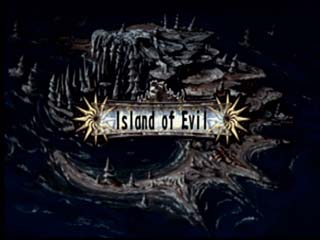
The
Infamous "Island of Evil".
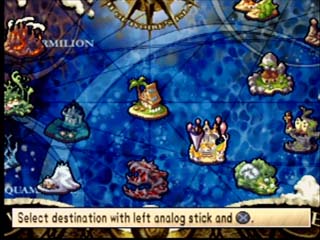
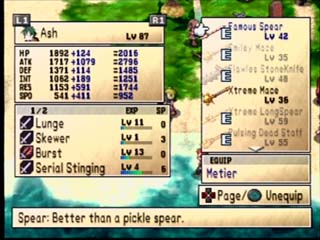
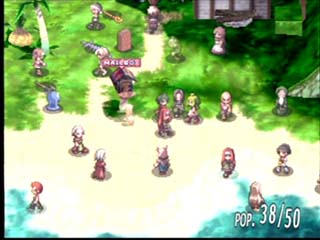
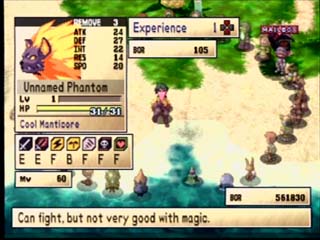
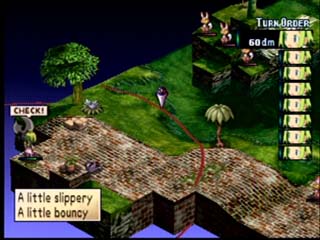
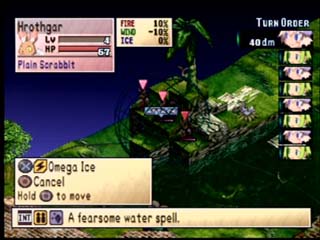
Setting
up and letting loose a spell
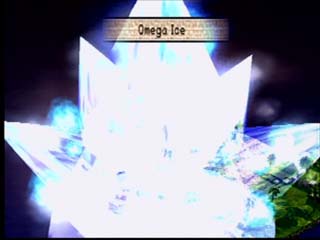
|

